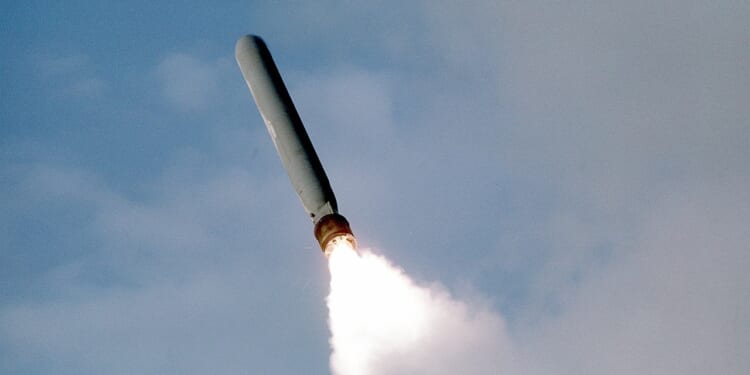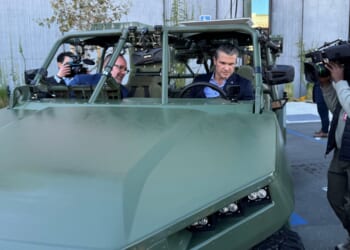Although Russia could likely shoot down some Tomahawks, others would penetrate its air defenses—prompting the Kremlin to warn of dire consequences if America supplies Ukraine with the missiles.
President Donald Trump has continued hinting that he is “leaning toward” making a decision about handing over a tranche of Tomahawk cruise missiles. Setting aside the way in which that will make any peace deal with Moscow ending the Ukraine War far more difficult, US defense analysts should get real about the effectiveness of the Tomahawk against an advanced, near-peer competitor, like Russia.
The Tomahawks can—and will—be intercepted by Russian air defenses. This is not mere speculation. It was conclusively demonstrated more than 25 years ago—and the Kremlin’s air defenses have only grown more advanced in the interim.
Serbia Shot Down American Tomahawks Years Ago
Tomahawks have a history of being detected and shot down by Russian equipment. Even the relatively weak Serbian military knocked US Tomahawks out of the sky in 1999, when the Clinton administration committed the US military to Operation Allied Force.
While the precise tally of Tomahawks shot down is unknown, and the US military officially denies that Serbia’s Russian military equipment took the cruise missiles down, we know that some of those missiles were taken down. An independent analysis of multiple open sources and post-conflict analyses indicates that the combination of radar tracking, surface-to-air missiles, guns, and electronic measures made at least some interceptions by Serbia in 1999 possible.
Layered air defense systems with radar tracking, such as S-125 Neva/Pechora, 2K12 Kub, and legacy systems, such as S-75/SA-2 air defense systems, when properly cued by radar, can engage low-altitude targets under some conditions.
Cruise missiles flying low to terrain can be hard to detect at long ranges, but with competent radar operators, overlapping sensor coverage, and persistence, early detection engagement becomes a possibility. In some instances, electronic warfare and jamming—spoofing—of guidance signals can also cause cruise missiles to deviate or fail to find their targets. During the 1999 conflict, Serbian forces used electronic warfare (EW) measures to complicate NATO operations.
How much this affected Tomahawks is debated. Some Tomahawks are designed with inertial navigation systems (INS) that reduce, but do not eliminate, vulnerability to jamming. But if the Serbs could do it with relatively old Soviet technology, there should be little doubt that the Russians can shoot down similar cruise missiles today.
What’s more, there were unconfirmed reports that, following President Trump’s Tomahawk cruise missile strikes in Syria back in 2017, the Russian military recovered fragments of one of the cruise missiles—and may have gotten their hands on an American-made INS system. While damaged, it is conceivable skilled Russian engineers could dissect this system to create countermeasures to it.
How Russia’s Air Defenses Work Against Tomahawks
Russian air defenses are fairly comprehensive. The Kremlin has layered sensors and multiple tiers of interceptors working together to detect and shoot down incoming Tomahawks. The Russians can employ electronic warfare (EW) techniques and so-called “soft kill” measures, which includes jamming, spoofing, and deception that can degrade guidance, communications, and GPS signals used by cruise missiles or their supporting targeting networks.
Considering that the only reason the Americans are even thinking about handing over Tomahawks to Ukraine is so that Ukraine can strike deep inside of Russia, it stands to reason that Moscow has already prepared itself on some level for defending itself against these attacks. After all, the Ukrainians will presumably fire their Tomahawks at large, strategically important areas of Russia. But the Russians can clearly anticipate where at least some of these attacks by Ukraine will be aimed at, and will have hardened key assets and dispersed forces so a given number of successful strikes cannot destroy command, control, or kill necessary for their defense. What’s more, Moscow has likely created a redundant communications and fallback sensor network to maintain situational awareness if primary nodes are degraded.
What Makes the Tomahawk an Effective Weapon?
Although the Tomahawk is an older weapons system, it remains a highly effective one. Although some Tomahawks have been shot down before, there is no perfect way in existence to ensure complete defense against the ubiquitous American cruise missile. The missiles fly at low altitudes and use terrain-masking techniques to reduce radar horizon and detection time by defenders. The small radar cross-section and subsonic speeds of the Tomahawk give defenders little time to detect, track, decide, and engage. Massed salvos and distributed launches can overwhelm a limited number of interceptors. Electronic resilience also plays a key role in keeping the lethality of Tomahawk cruise missiles at peak performance levels.
Because US designers are aware of Russian air defenses, they have created electronic resilience for these missiles. Tomahawks use GPS and INS combos and other hardening measures against jamming, complicating EW effects that Russians would likely deploy in defense against incoming Tomahawk cruise missiles.
This is why Moscow has made clear that they view any decision to place Tomahawks in the hands of the Ukrainians as a real escalation by the Trump administration against Russia—that would require immediate, real, and direct action by the Russians against NATO and American targets. Of course, Russia has drawn red lines before, and declined to pursue war on the West when they were crossed. But with the prospect of such a war so daunting, America and NATO should not push their luck.
Russia Has Adapted. Act Accordingly, Washington!
The reality, though, is that the Tomahawk is not the game-changing super weapon its proponents in Kyiv and Washington believe it is. It might have been back in 2014, when the Russians invaded Crimea. But the Russian Armed Forces have since had ample time to study and adapt to the US cruise missile threat.
Further, Moscow’s forces are keenly aware of the logistical limitations of the Americans at this most desperate time for their defense industrial base. The Americans could never provide Ukraine with sufficient levels of the weapon for it to even be effective—even disregarding all the technical capabilities Russia possesses for shooting these weapons down.
A better use of time for Washington would be in preparing Brussels and Kyiv to make peace with Moscow. Sadly, such a peace deal seems further away than ever. So Russia will simply continue grounding on with the war in Ukraine—and, slowly but surely, winning.
About the Author: Brandon J. Weichert
Brandon J. Weichert is a senior national security editor at The National Interest. Recently, Weichert became the host of The National Security Hour on America Outloud News and iHeartRadio, where he discusses national security policy every Wednesday at 8pm Eastern. He is also a contributor at Popular Mechanics and has consulted regularly with various government institutions and private organizations on geopolitical issues. Weichert’s writings have appeared in multiple publications, including The Washington Times, National Review, The American Spectator, MSN, The Asia Times, and others. His books include Winning Space: How America Remains a Superpower, Biohacked: China’s Race to Control Life, and The Shadow War: Iran’s Quest for Supremacy. His newest book, A Disaster of Our Own Making: How the West Lost Ukraine is available for purchase wherever books are sold. He can be followed via Twitter @WeTheBrandon.
Image: Wikimedia Commons.

















